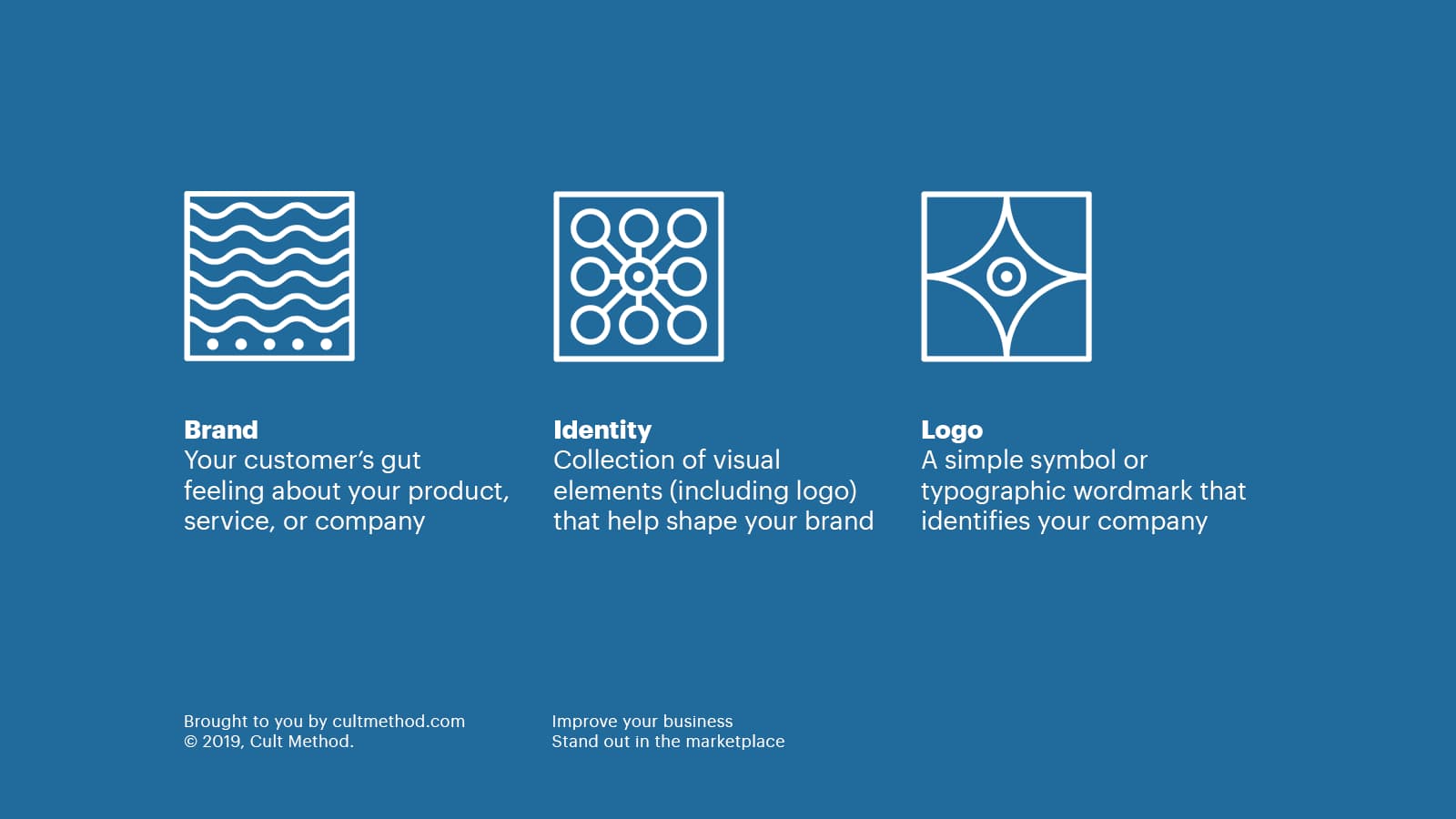Table of contents
New and prospective clients who come to CultMethod for help with visual identity design or naming occasionally ask me: “Why is brand strategy important, anyway?”
It’s a tough question to answer. Not because there isn’t enough to say, but because there is so much to say. In the immortal words of G.K. Chesterton:
If one asked an ordinary intelligent man, on the spur of the moment, ‘Why do you prefer civilization to savagery?’ he would look wildly round at object after object, and would only be able to answer vaguely, ‘Why, there is that bookcase … and the coals in the coal-scuttle … and pianos … and policemen.’ The whole case for civilization is that the case for it is complex. It has done so many things. But that very multiplicity of proof which ought to make reply overwhelming makes reply impossible.
When people ask me about the benefits of brand strategy, I often feel the same way. Usually I tailor the answer to the impact I believe it would have on their business, but in this article I will try to present the whole case for brand strategy.
Before we get ahead of ourselves, let’s take a step back to make sure our understanding of the different terms is crystal clear.
Often times, the terms brand and brand strategy are used sloppily and even interchangeably. They get tossed around in business development meetings and conversations without a clear understanding of what they actually mean, and how they are different from one another. As a result, the terms devolve into corporate gobbledygook and communication around one of the most important aspects of a business falls apart.
Let’s change that.
What’s the difference between brand strategy and your brand as a whole?
First, let’s begin with the definition of “brand”. It’s a well-known fact that for a lot of companies, their brand is their single most valuable asset.
Consider this: The value of the materials in a Nike shoe is at most a couple of dollars. But when Nike puts their logo on them, people are willing to pay hundreds of dollars to get their hands on a pair. Interbrand, the global brand strategy firm, values the Nike brand at over $30 billion dollars.
So it’s no surprise that one of the first things most new businesses set out to do is establish a strong brand. They invest time and money in a great-looking logo and a memorable name. These are very important things, and it’s important to get them right. But what a lot of business owners fail to realize is that your brand is so much more than just a name or a logo.

Your brand is something intangible yet incredibly powerful at the same time. You can think of it as the gut feeling generated when a customer thinks of you. It can be strong or weak, good or bad.
Here is my definition of brand:
- Your brand is the emotional connection that customers have with your business. It is shaped by your name, logo, overall visual and verbal identity, marketing and advertising, and—most importantly—the experiences customers associate with you.
If your brand is strong, it will do a lot of good things for you. Here are a few:
- Your brand will generate customer loyalty and word-of-mouth marketing
- Your brand will set you apart from other competitors in the marketplace
- Your brand will allow you to command premium pricing for your products or services
Consider for a second some of the most well-known companies: Coca-Cola, Starbucks, and Apple. These brand names immediately trigger a world of associations and feelings when you hear them. In fact, doctors at a German research university found that strong brands elicit strong activity in our brains.
At this point we have a pretty good idea what “brand” means, and why we should care about it.
As observant readers have probably realized, a struggle you face as a business owner is that your brand lives in the minds of consumers.
That means your most valuable business asset is out of your direct control (unless you’re somehow in possession of a mind-control machine). But you can take action to change your brand indirectly. In fact, almost everything you do inside your business can affect your brand in some way — both negatively and positively.
But how do you know what actions to take and what changes to make in order to strengthen your brand?
How do you even know what sort of brand you want to have? Should customers perceive you as youthful and friendly, or mature and corporate? Perhaps you want to be perceived as innovative — but how will your customers respond to that if they happen to be a risk-averse bunch?
This is where brand strategy comes into play.
You see, your brand strategy provides answers to all those questions. I like this definition of brand strategy:
Brand strategy is the ‘big picture’ plans and tactics deployed by an organisation/brand owner to create long-term brand equity and competitive advantages from branding.
Or in plain English, brand strategy is a plan to actively influence how people perceive your brand. It clarifies where your company is headed, what you are trying to achieve, and provides a map and compass, setting your True North so to speak, to help you get there. It helps you figure out what to do, and perhaps even more importantly, what not to do.
Why is brand strategy important?
If you want to cultivate a good brand, your business needs a brand strategy.
An effective brand strategy helps you cultivate a strong brand. It defines who you are as a business, and focuses your long-term goals. It also sets a benchmark to measure progress against: Without a brand strategy, you have no way to judge whether your brand is moving in the right direction or not.
Too vague for your liking? Here are some tangible benefits of brand strategy:
1. Helps you articulate and communicate your core values
People don’t buy what you do, they buy why you do it. If you want to attract loyal customers, you need to figure out what your brand stands for, and how to communicate that to consumers.
2. Helps you identify weaknesses in your brand experience
If the experiences that your customers have with your company are not consistent, you will struggle to build trust and customer loyalty. In the words of Marty Neumeier, author of The Brand Gap, “Customers trust your brand when their experiences consistently meet or beat their expectations.”
3. Filter out ill-advised ideas that would damage your brand-building efforts
It’s easy to succumb to shiny-object syndrome. A clear brand strategy makes it easier to make prudent decisions.
Should we jump on the bandwagon of this new marketing trend? Would this new product idea actually be useful to our ideal customers? Just refer back to your strategy booklet to be reminded about the long-term vision and check if the initiatives you’re considering are in alignment with that vision.
In the words of David Ogilvy, who’s known as the father of advertising:
Every advertisement should be thought of as a contribution to the complex symbol which is brand image.

4. Creates accountability
In the same vein as the previous point, committing to a clear brand strategy helps keep everyone in your organisation accountable, focused on high-yield initiatives that will actually move the needle rather than glorified busywork.
Strategy helps you stay on track — and if you do fall off track, it helps you refocus and get back to where you need to be faster.
5. Achieve laser focus in your marketing efforts
By narrowing and clarifying the scope of your marketing efforts, you can ensure smoother and more effective execution of marketing campaigns. You know who you’re targeting, you know what they care about, and you know how to speak to them.
Instead of wasting thousands of dollars A/B testing different campaigns, you’ll hit the mark faster and maximize the return on investment of your marketing efforts.
6. Increases the valuation of your company
Startups will love this one. Whether you’re planning for an exit, or looking to raise capital from investors, having a clear brand strategy shows potential buyers and investors that you’ve thought carefully about how to grow the most valuable asset of your business, which can help justify a high valuation.
7. Helps designers and creatives do better, more effective work
What should your logo look like? What tone of voice should your sales copy have? Is this palette better than that one?
Without a strategy to underpin them, creative decisions are inherently subjective and arbitrary.
Very often, major decisions about logo designs, color palettes, or sales copy are made based on what someone’s spouse thinks about this or that aspect of the design. If you have a clear strategy, you can judge the effectiveness of a particular design or piece of copy by how well it reflects the strategy.
After all: You might love strawberries or spaghetti, but that doesn’t mean you should use them as bait when you go fishing.
8. Gets everyone on the same page
Organisations are like rowing teams. If anyone on the team tries to row in a different direction or falls out of rhythm with everyone else, it’s pretty hard to beat the competition. A major part of the brand strategy process is aligning the different people on your team, and getting them to buy into the vision and values of your brand.
Engaged employees get more done, are better at serving customers, and bring in more profit to your company. (Source)
Components of an effective brand strategy
Depending on the size and nature of your business, your brand strategy may need to include different components. The brand strategy process we went through with Factorion, a smart industry consultancy in the Netherlands looks very different from the processes that Fortune 100 companies may go through with their strategists.
With that in mind, here are the things we always include in the brand strategy process that we do with clients.
1. Core values
These are the beliefs that inform everything you do. They’re the reason you’re in business in the first place (beyond making money).
Your core values are heavily influenced by the values of the company founder/leader, and they’re unlikely to ever change. Apple wouldn’t be Apple if it weren’t for Steve Jobs (and the further Tim Cook strays from Steve Job’s values of design and product innovation, the worse it’s going to be for Apple’s brand).
2. Strategic positioning statement
IKEA is positioned as a manufacturer of affordable yet contemporary furniture. Ralph Lauren is positioned as a premium brand for preppy fashion. Abercrombie & Fitch is positioned as a fashion-forward (and slightly preppy) brand for young and good-looking people.
How do you want to position yourself in the minds of your customers? You can’t hit a target if you don’t know where to aim. At CultMethod, we conduct competitive research to identify potential opportunities for a sharper positioning statement.
3. Ideal customer profile(s)
Who are you trying to attract to your business? If you try to be anything for everyone, you’ll soon be forgotten by customers.
Your target audience should be laser focused. American readers will be familiar with Trader Joe’s (a grocery chain). Their ideal customer is “an unemployed PhD student … with acquired taste and not part of the mass TV culture, and maybe a wine drinker”. (Joe Coulombe, founder of Trader Joe’s, Nov 1986 — source)
Now, in the grand scheme of things, there may not be that many unemployed PhD students around. But the unemployed PhD student embodies a very real and large segment of the market: well-educated and cost-conscious people who want quality at an affordable price.
4. Brand promise
When you know your brand values, strategic positioning, and ideal customer personas, developing your brand promise becomes easy. A brand promise is the message that speaks to your target audience. It tells them what to expect when they interact with your brand. A good brand promise is simple, credible, different, relevant, and inspiring. As an example, Nike’s brand promise is: “To bring inspiration and innovation to every athlete* in the world.” The asterisk signifies that if you have a body, you’re an athlete.

5. The look and feel of your brand identity
We all know what a difference great-looking design and strong copywriting can make to the success of a company or product. As humans, we’re drawn to beautiful things. A good strategy can guide the creative expressions of your brand identity to make sure they are aligned with your positioning goals and the tastes of your ideal customers.
6. Prioritized brand touchpoints and awareness-drivers
Your brand touchpoints are any points of contact between your business and consumers. They can include your marketing website, email newsletter, social media accounts, brick-and-mortar stores, customer support lines, and product packaging—to just name a few.
A good brand strategy will help you focus on the most important, high-yield touchpoints to avoid spreading your organisation too thin.
7. The voice and tone of your brand, as well as specific messaging
Besides defining what touchpoints to focus on, your brand strategy should also provide at least a loose framework around how you communicate (is your tone fun or serious, for example?).
Email service provider Mailchimp has in-depth guidelines that ensure their communication is both consistent and aligned with their brand strategy. For example:
Using offbeat humor and a conversational voice, we play with language to bring joy to [customers’] work. We prefer the subtle over the noisy, the wry over the farcical. We don’t take ourselves too seriously.
Who should develop a brand strategy?
Anyone who aspires to turn their business into an esteemed brand needs to think carefully about their brand strategy.
I’m especially intrigued by the opportunities for small businesses to leverage brand thinking in order to gain an edge on their competition. Among major corporations, the importance of branding—and brand strategy—is already widespread. But many small businesses haven’t caught on yet, which means there’s a big opportunity for smart founders and CEOs to get ahead.
We’ve worked with both established businesses and early-stage startups to help them develop and clarify their strategies.
Developing a brand strategy as an early-stage startup can help you avoid a lot of mistakes and save both time and money down the line. Developing a brand strategy as an established company can help you revitalize your business and tackle things from a new angle.
Do you have a brand strategy? (+ free worksheet)
Now, I’d love to hear from you. Does your company have a brand strategy in place already? What benefits did you get from the process?
Or maybe you’re still researching the subject, trying to figure out the best way to move forward. Do you have any questions that I might be able to answer? I’ve run dozens of brand strategy workshops for clients — I’d love to help if I can.
Or perhaps you disagree with something in this article. If so, don’t be afraid to tell me. I’d love to hear from you.
Send me an email at jon@cultmethod.com and I’ll get back to you as soon as possible.

Jon Persson
Jon Persson

Hiring a designer? Grab this.
My Pre-Hire Checklist gives you valuable tips to consider before hiring an identity designer.


